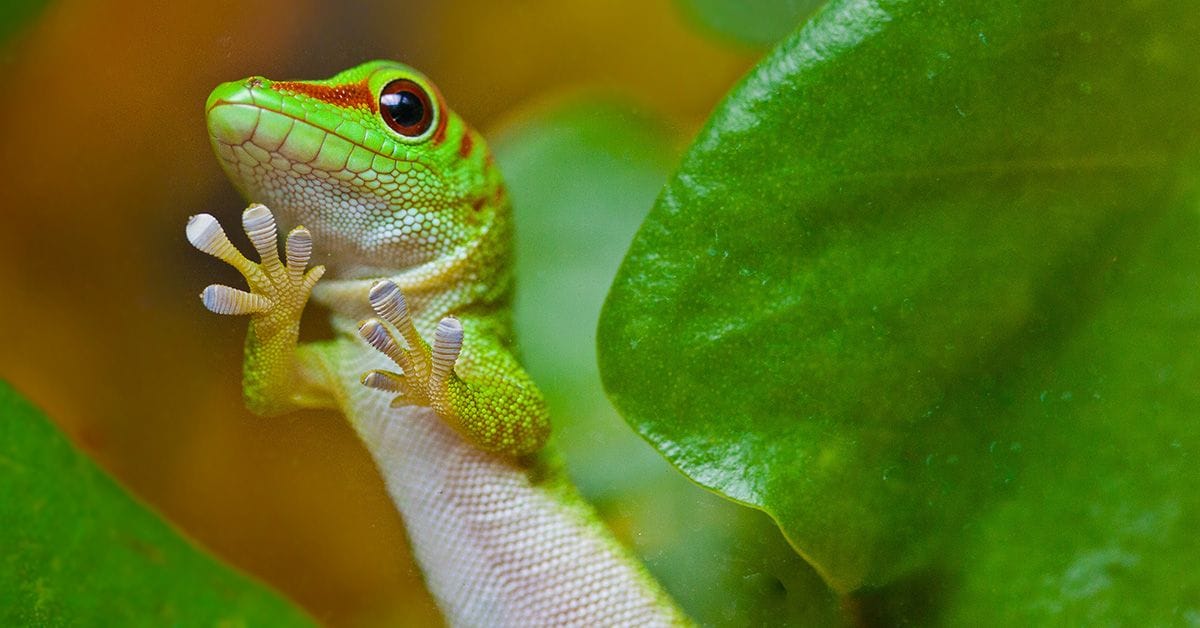Slips and falls are one of the most common and costly accidents for millions each year. But scientists have gripped onto a new idea for hydrophilic, slip-resistant shoe soles inspired by geckos' sticky footpads.

Every year, over 37 million people have accidents caused by slipping and falling on ice or other wet surfaces. According to the World Health Organization, this is the second most common cause of accidents and occupational health hazards.1 Existing slip-resistant footwear and materials, such as hydrophobic soles and innovative tread designs, tend to wear out and can be useless when they get blocked. But many animals are capable of moving through slippery environments without event, so could there be an answer in nature?
The key challenge is that ice gets slippery when wet due to the constant generation of a nanometer Quasi Liquid Layer (QLL).2,3 Conventional anti-slip solutions tend to rely on hydrophobicity to repel the QLL. The adhesion behavior of superhydrophobic surfaces is an active research field in several other engineering applications beyond ice-safe footwear: for example, in controlled microdroplet transportation, self-cleaning, biochemical separation, tissue engineering, and water harvesting.4
But some animals, such as the gecko, take the exact opposite approach—hydrophilicity. In other words, they handle surface moisture by absorbing it and harnessing capillary phenomena to suction themselves to surfaces. Microscopy has shown that a gecko's foot is covered with about 500,000 keratinous hairs called setae. Each seta, at only 30–130 micrometers long and one-tenth the diameter of a human hair, contains hundreds of projections ending in spatula-shaped structures.5 With such incredibly adhesive feet, geckos also have a specific method of uncurling and "peeling" their toes away from surfaces to break the forces generated. Now, work published in ACS Applied Materials & Interfaces suggests we can use this gecko-inspired knowledge to put hydrophilicity to work instead of trying to repel the QLL.
To explore this, the team developed a capillary-enhanced adhesive material that can resist slips on wet and icy surfaces. The idea is based on the QLL being immediately absorbed and frozen inside the microcavities— generating traction—and followed by detachment in subsequent footsteps.6
The researchers compounded silicone rubber with zirconia nanoparticles, using laser surface texturing to create microfibrillar capillaries. Silicone rubber is already widely used for shoes since it is stable, durable, flexible, and resistant to extreme conditions. The zirconia was chosen because it is a high surface energy oxide that can attract polar liquids like water and create a capillary effect. The modified rubber was integrated into a hard outsole with hexagonal treads to remove excess QLL, supporting softer gecko-like cavities among micropillars. These capillaries were designed to effectively absorb the QLL and freeze upon contact with ice, providing mechanical interlocking while still able to easily peel off for detachment. In tests, the innovative surface showed promising hydrophilicity-induced capillary suction and mechanical interlocking.
Further Explorations: Gecko-Inspired Anti-Slip Innovations
Other teams are also taking inspiration from geckos to develop their own anti-slip materials. A November 2024 study in ACS Applied Materials & Interfaces describes a self-powered, anti-slip, and multifunctional smart outsole built from gecko-inspired tilted magnetized flakes and flexible coils.7 By using pressure-induced flake deflection and a built-in magnetic moment alignment, this system is able to produce a variable magnetic field that can induce voltage signals in coils for precise pressure perception and linear velocity sensing. This means the outsole behaves as a real-time footwear recorder that can be used for exercise analysis. The gecko-like design also delivers excellent anti-slip capabilities with a high friction coefficient, abrasion resistance, and environmental immunity.
Additional studies have focused on how factors such as relative humidity can affect the frictional-adhesion behavior of gecko-inspired pads.8 This has found that appropriate control of the loading path allows transition between strong attachment and easy detachment. Changing the preload and shear direction gives rise to differences in the effective contact area at each fiber and the microscale and nanoscale structure of the contact, while changing the relative humidity results in differences in the relative contributions of van der Waals and capillary forces. The shape of the micropillar arrays is also important.9 In nature, gecko setae have a spatula shape, but research into gecko-inspired dry adhesives is looking at micropillar arrays with different terminal shapes, such as flat, spherical, and mushroom tips, as well as bioinspired spatulas. An important consideration is that the techniques needed to achieve the different arrays—such as lithography, etching, and deposition—can be complex, expensive, and environmentally unfriendly. However, ultraprecision machining and replica molding could be an alternative approach.
These breakthroughs in understanding how creatures naturally move through slippery environments could represent a robust, durable solution to significantly reduce slips and falls on ice surfaces—saving both lives and livelihoods.
References
- Falls. World Health Organization 2021. https://www.who.int/news-room/fact-sheets/detail/falls
- Alejandra Sánchez, M. et al. Experimental and Theoretical Evidence for Bilayer-Bybilayer Surface Melting of Crystalline Ice. Proc. Natl. Acad. Sci. U.S.A. 2017, 114 (2), 227–232.
- Furukawa, Y. and Nada, H. Anisotropic Surface Melting of an Ice Crystal and Its Relationship to Growth Forms. J. Phys. Chem. B 1997, 101 (32), 6167–6170.
- Nine, M. J. et al. Facile Adhesion-Tuning of Superhydrophobic Surfaces between “Lotus” and “Petal” Effect and Their Influence on Icing and Deicing Properties. ACS Appl. Mater. Interfaces 2017, 9, 9, 8393–8402.
- Autumn, K. et al. Adhesive force of a single gecko foot-hair. Nature 2000, 405 (6787), 681–685.
- Richhariya, V. et al. Capillary-Enhanced Biomimetic Adhesion on Icy Surfaces for High-Performance Antislip Shoe-Soles. ACS Appl. Mater. Interfaces 2025, 17, 1, 2450–2461.
- Zhou, Q. et al. Bioinspired Tilted Magnetized Flakes as a Self-Powered and Antislip Smart Outsole for Healthcare Monitoring and Human–Machine Interaction. ACS Appl. Mater. Interfaces 2024, 16, 46, 64197–64209.
- Cadirov, N. et al. Influence of Humidity on Grip and Release Adhesion Mechanisms for Gecko-Inspired Microfibrillar Surfaces. ACS Appl. Mater. Interfaces 2017, 9, 16, 14497–14505.
- Zhou, T. et al. Gecko-Inspired Biomimetic Surfaces with Annular Wedge Structures Fabricated by Ultraprecision Machining and Replica Molding. ACS Omega 2021, 6, 10, 6757–6765.
